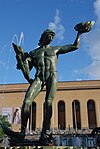Gothenburg discothèque fire
You can help expand this article with text translated from the corresponding article in Swedish. (November 2019) Click [show] for important translation instructions.
|
| Gothenburg discothèque fire | |
|---|---|
 Claes Hake's memorial for the dead, unveiled on the tenth anniversary of the fire in late-October 2008 | |
| Location | Gothenburg, Sweden |
| Date | 29 October 1998 c. 23:40 (CET) |
Attack type | Arson, mass murder |
| Deaths | 63 |
| Injured | 213 |
| Perpetrators | Shoresh Kaveh Housein Arsani Mohammad Mohammadamini Meysam Mohammadyeh |
| Motive | Retaliation for being denied free entry into the discothèque |
The Gothenburg discothèque fire was caused by an
Fire
The fire started on the premises of the Macedonian organization on the third floor, where a
The first
Victims
A total of 63 young people were killed and 213 were injured, of whom 50 seriously.
Investigation
On 1 June 1999, it was reported that two suspects had been arrested but later released. In December 1999, a reward of 3 million
Criminal prosecution
This section needs additional citations for verification. (October 2017) |
The fire had been set by four teenagers aged 17–19, who had been denied entry to the disco as a result of an argument. All four were charged and found guilty of aggravated arson, and the firestarter, Shoresh Kaveh, was sentenced by the district court in 2000 to eight years' imprisonment. Two others, Housein Arsani and Mohammad Mohammadamini, were sentenced to six years in prison, while the fourth, Meysam Mohammadyeh, who was a minor at the time of the offence, received three years in a juvenile care facility. Both the defendants and the prosecution appealed the sentences. The court of appeals upheld two of the verdicts, but the two verdicts of six years' imprisonment were raised to seven years.
Mohammadyeh, nicknamed the youngest by the press, was represented by Leif Silbersky. It was established that the other three suspects were friends, and although Mohammadyeh had wanted to become friends with two of them, he was afraid of Kaveh.[10] Silbersky asked for Mohammadyeh to be acquitted, as in his opinion thought Mohammadyeh should not be held legally responsible for his passivity.[11] The court of appeals, however, considered it proven that the four "had mutually agreed to ruin the party by starting a fire", and that it was of "decisive importance with regards to the question of guilt that it had not been possible to prove that no other person or persons than Kaveh had torn the paper or started the fire in the stairway."[10] Professor Christian Diesen is of the opinion that it is possible that Mohammadyeh had "become involved in a sequence of events he had no control over and would have been judged differently if the fire had not had such devastating consequences."[12] The penalties may be regarded as mild by international comparison, but Swedish law at the time allowed those aged 18–20 to be sentenced to a maximum of 8 years of prison, which was given to the leader. Those under 18 are given prison only for severe violent crimes, a maximum of 4 years.
The case was prosecuted by Thomas Bodström, who later became Minister for Justice in Sweden.
Legacy
Relatives of the victims later founded the
On the tenth anniversary of the fire in 2008, a permanent memorial was unveiled, made out of polished granite with the name and age of each victim engraved in gold. The monument was placed at Backaplan in the part of Hisingen where the fire occurred. It was designed by the artist Claes Hake.
References
- ^ "Dance Hall Fire" (PDF). Archived from the original (PDF) on 31 March 2010. National Fire Protection Association. Retrieved on April 3, 2008
- ^ "60 dead in Sweden dance hall fire". CNN. 1998. Archived from the original on September 7, 2005. Retrieved April 30, 2008.
- ^ P3 dokumentär Archived 2009-02-03 at the Wayback Machine
- ^ a b c d Sirenen no. 6, September 2008
- ^ Hansson, Annika; Werner, Anna (November 5, 1998). "Affischer ska piska upp hatstämning i Göteborg". Aftonbladet (in Swedish). Gothenburg. Retrieved July 23, 2015.
- ^ Rönn, Cina (August 29, 2000). "Skärpta straff för diskobranden" [Longer sentences for discothèque fire]. Aftonbladet (in Swedish). Retrieved July 23, 2015.
- ^ "Gärningsmännen" [The perpetrators]. Göteborgs-Posten (in Swedish). October 26, 2008. Archived from the original on October 29, 2008.
- ^ Atterstam, Inger; Engström, Annika (October 26, 2008). "Vi glömmer aldrig - Tio år efter branden på Backaplan" [We never forget - ten years after the fire at Backaplan]. Svenska Dagbladet (in Swedish). Retrieved July 23, 2015.
- ^ Johansson, Anders (April 26, 2000). "Branden i Göteborg: Åtalet offentligt" [The fire in Gothenburg: The indictment public]. Aftonbladet (in Swedish). Retrieved July 23, 2015.
- ^ a b "Hovrättens dom" [Verdict of the Court of appeals] (in Swedish). Sveriges Radio. Archived from the original on December 16, 2003.
- ^ Sjödin, Stefan (June 9, 2000). "Ny rättegång i juli. Minst tre av de dömda kommer att överklaga" [New trial in July. At least three of those convicted will appeal]. Aftonbladet (in Swedish). Retrieved July 23, 2015.
- ^ Diesen, Christian (2000). "Göteborgsbranden, Malexander- och Söderbergsmorden – svåra mål i teorin, enkla i praktiken?" (PDF). Juridisk Tidskrift (in Swedish) (3). Archived from the original (PDF) on March 26, 2009.
External links
- United States National Fire Protection Association report
- Analysing the Gothenburg fire
- Brandrättegången i Göteborg (article about the fire trial in Gothenburg, in Swedish)
- P3 dokumentär (documentary by the Swedish radio stationP3)
- Brandoffrens anhöriga (homepage of BOA)

